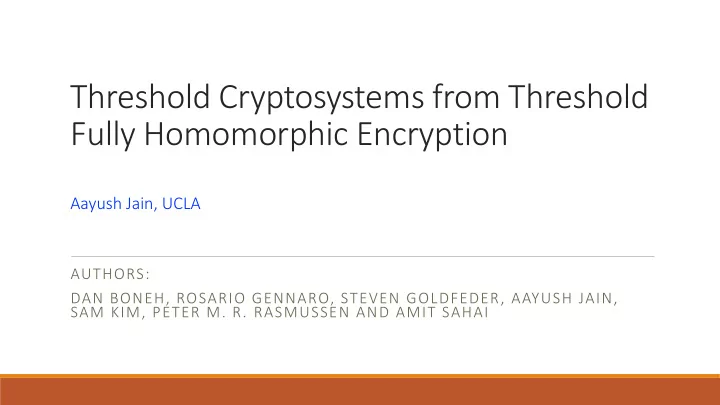

Threshold Cryptosystems from Threshold Fully Homomorphic Encryption Aayush Jain, UCLA AUTHORS: DAN BONEH, ROSARIO GENNARO, STEVEN GOLDFEDER, AAYUSH JAIN, SAM KIM, PETER M. R. RASMUSSEN AND AMIT SAHAI
Introduction to Characters Thanos: Bad Guy Tony Stark: Good Guy
Key Management For security, need to have private information.
Key Management
Key Management Key Management is prone to side channel leaks, social hacking, human error etc.
Main Question Can we address this issue at more fundamental level?
Threshold Cryptography Secret Sharing
Threshold Cryptography
Threshold Cryptography (t out of n)
Threshold Signatures
Threshold Signatures Requirements: Unforgeability, Compactness, Correctness, Robustness etc..
Threshold Public Key Encryption
Threshold Public Key Encryption Requirements: CCA Security, Compactness, Correctness, Robustness etc..
Related Works RSA Signatures [Fra89, DDFY94, GRJK07, Sho00] Schnorr Signatures [SS01] (EC)DSA Signatures [GJKR01, GGN16] BLS Signatures [BLS04, Bol03] Cramer-Shoup Encryption [CG99] Many More [SG02, DK05, BBH06, … ]
Our Results • Construct Threshold Fully Homomorphic Encryption (TFHE) • Formalised the concept of Universal Thresholdizer (UT). • Show how to use UT as a general tool for constructing threshold cryptosystems • Construct UT from TFHE. • New Constructions for a variety of threshold cryptosystems: Threshold Signatures, CCA secure PKE, distributed PRFs, Function Secret Sharing from LWE
Threshold Fully Homomorphic Encryption
Threshold Fully Homomorphic Encryption (TFHE)
Security Definitions
Starting Point: [GSW13] FHE Scheme
Recap: [GSW13]
Recap: [GSW13]
Very First Observation
Initial Idea Noise leaks too much information (in form of linear equations), and leads to attacks! FHE decryption should just reveal message
Smudging with noise Correctness is lost!
How to Fix Noise Blowup? • Define a new linear secret sharing scheme with low-norm reconstruction coefficients. • Two ways of doing that: 1. A general purpose secret sharing scheme supporting broader access patterns. 2. More direct modification of Shamir Secret Sharing scheme leading to shorter keys, albeit slightly larger ciphertexts.
{0,1}-LSSS
How Expressive is {0,1}-LSSS? And OR And
How Expressive is {0,1}-LSSS
Recap Correctness is not lost! Needs careful Security Analysis
More direct way
Comparison of two schemes Ciphertext /Public Key Size Key Size/Partial Decryption Access Structure Size {0,1}-LSSS Scheme Monotone Boolean Formulas Clearing Threshold Access Denominators Structures
Threshold Signatures
Universal Thresholdizer
Our Results • Construct Threshold Fully Homomorphic Encryption (TFHE) • Formalised the concept of Universal Thresholdizer (UT). • Show how to use UT as a general tool for constructing threshold cryptosystems • Construct UT from TFHE. • New Constructions for a variety of threshold cryptosystems: Threshold Signatures, CCA secure PKE, distributed PRFs, Function Secret Sharing from LWE
Application of Techniques Lazy MPC [BJMS18]: An MPC where honest parties can ``go to sleep” - limited computing power, lost connection etc.. Theoretical Outcome: First MPC with Guaranteed Output Delivery in the standard model in three rounds (Concurrent with [ACGJ18]). Amplification: Given an FE/iO candidate with partial security, output a fully secure candidate. Appeared in [AJKS18]
Open Problems Not relying on FHE? (More efficient construction) More applications Better assumptions? (polynomial approximation factor)
Recommend
More recommend